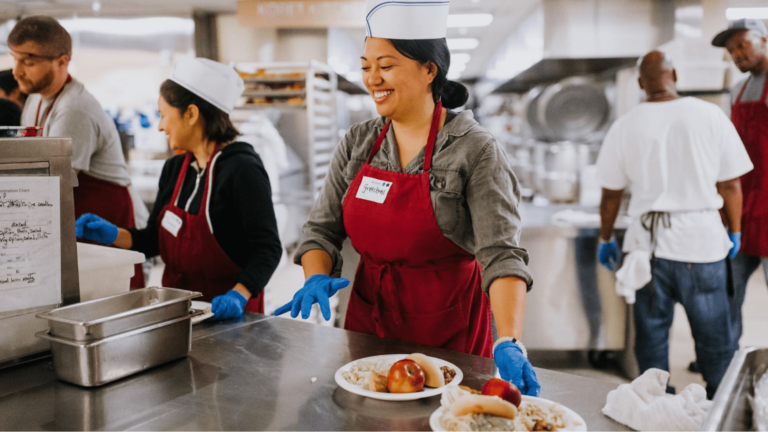Events are the lifeblood of small nonprofits — they’re a wonderful way to increase brand awareness and raise money from the community.
However, events also serve as an opportunity to gain new supporters and build meaningful relationships to advance your mission. That’s why it’s crucial to create an event that makes a lasting impact.
The good news is that you don’t have to leave this to chance. At Eventbrite, we support a robust community of nonprofit organisers, and we’re here to share their event-planning secrets with you.
This article will explain how audience targeting can lead to more ticket sales and the basic nonprofit event planning strategy every organiser needs to master. We’ll also share some pro tips to help you create an amazing event that skyrockets your attendance and brand.
Finally, we’ve included a free, downloadable nonprofit event planning checklist to help you stay organised.
Why strategic audience targeting is the key to nonprofit event success
With so many nonprofits competing for attention and resources, it’s essential to have a concrete plan that focuses on understanding your unique community and its needs.
As of 2023, there are approximately 1.54 million nonprofit organisations in the US. This means nonprofits need to work harder than ever to stand out and make a positive impact.
One of the most common reasons nonprofits fail is because they lack a concrete plan — not just for their overall mission, but also for the specific events they organise.
Yes, it’s important to have a strong message, but without fully understanding your community, it’s likely you’ll struggle to create a compelling event and sell tickets.
It’s essential to create an event that aligns with your unique brand and mission while speaking to the needs and desires of your audience. This can help you build a strong relationship with your community and increase the impact of your nonprofit events.
For example, Recoup is the UK’s leading independent authority on plastics resource efficiency and recycling. RECOUP organise events such as thier annual awards ceremony and RECOUP conference for businesses and individuals with inters in waste management and recycling. These event organisers have an exceptional understanding of their target audience which has allowed them to create highly original events and develop a cult-like following.
Recoup doesn’t just offer attendees an opportunity to contribute to a worthy cause; they deliver an enjoyable and unforgettable experience that offers real value to their attendees.
But how do you know what your audience wants?
Using event management software like Eventbrite gives you access to detailed audience data through:
- Audience reports and analytics
- Smart targeting and insights
- Custom post-event surveys
Using this data, you can gain valuable information on what your current audience and potential new attendees are responding to in your marketing campaigns and past events. This can help you identify preferences and trends within your community that you can leverage to create a successful nonprofit event.
Engage your audience with our all-in-one event marketing platform

Master the basics of nonprofit event planning: your 10-point checklist
Even if you know exactly why you’re throwing an event and you have a strong understanding of your target audience and great volunteers ready to help, a slight misjudgment can derail your nonprofit event completely.
That’s why, for even the most experienced event planners, it’s essential to have a checklist of the steps you need to take during and after the event to ensure everything stays on track.
Phase 1: brainstorming
The first stage of the process is assessing your target audience, budgetary restrictions, and event goals, and brainstorming creative event ideas that keep costs low.
1. Create measurable goals for your event
Crafting measurable goals is the cornerstone of a successful event, and it all begins with pinpointing the core essence of your event. Yes, you want to attract as many new community members as possible, but if you had to narrow it down to one goal, would it be to raise funds or promote awareness?
Distilling the purpose of your event to one single target will help you make your goals more specific and measurable (aka SMART goals), which you can use to inform the decisions you make throughout the planning process.
Focused fundraising goals examples:
- Setting a precise monetary goal
- Striving to sell a specific number of tickets
- Creating a targeted donor engagement campaign
Focused awareness goals examples:
- Building relationships with local micro-influencers
- Strengthening community ties by networking with local businesses
- Securing new event sponsors
Focusing on one target doesn’t mean you’re neglecting the other, it simply provides clarity on the aspects of the event that require prioritisation during your planning process. For instance, if your primary goal is to increase attendance, you might want to invest more resources in phase three (event promotion).
💡Pro tip: When setting the target for your charity event, don’t forget about the importance of building ties with community organisational leaders who share your audience.
2. Determine your budget
To maximise your return on investment (ROI), it’s crucial to keep operational costs as low as possible when planning a nonprofit event. Creating a comprehensive event budget is the most effective way to achieve this.
It’s important to try making these estimations as accurate as possible. To do this, conduct market research on how other successful nonprofit events are using cost-saving strategies to manage their finances while still throwing top-notch events.
Also, revisit historical data from past events you’ve hosted to analyse what worked well and where you can decrease costs for this event. For example, you may have received a discount from a venue for being a nonprofit organisation. Consider reusing this location or negotiating a similar discount with your next venue to save on costs.
Break down your event budget into the following categories:
- Venue rental
- Catering and beverages
- Decorations and aesthetics
- Performers or special guest
- Permits and licences
- Marketing and promotional expenses
- Equipment and supplies
- Insurance
- Miscellaneous costs
- Emergency fund
Using event management software like Eventbrite can help you optimise your spending and track expenses across your entire event, such as ticket prices, sales, and promotion.
💡Pro tip: Use our event budget template worksheets to help estimate the costs of things like venue rentals and guest presenters in the planning stage. Post-event, you can check it against your actual budget to see where you overestimated costs and areas where you might be able to reduce spending in the future.
3. Pick which type of event would appeal to your audience
Choosing the right event type is crucial when creating an event your target audience actually wants to spend money on. At the end of the day, even if you’re promoting a worthwhile cause, if you’re hosting boring events, expect to see a decline in ticket sales.
To create a successful nonprofit event, it’s important to consider your brand’s unique identity and values and what types of events appeal to your potential donors. Don’t be afraid to think outside of the box.
You don’t have to stick to traditional nonprofit event types to be successful — sometimes, a bit of innovation is all you need to raise awareness and stand out!
Some creative event ideas include:
- Virtual reality charity gala
- Outdoor adventure challenge
- Glow-in-the-dark fun run
- DIY gardening workshop
For instance, RSPCA Woodside Animal Centre stands out by hosting car boot sales tailored to animal lovers. From used dog leads to puppy crates, their inventive approach sparks interest in their existing community and is memorable enough to attract new attendees.
💡Pro tip: Use event reports to track the success of your other events and determine which event type attracts the most ticket sales.
Phase 2: locking down the event details
Now that you’ve decided on a great event idea, it’s time to get the logistics sorted and call on your local community ties.
4. Choose a venue
When choosing a venue, it’s essential to select one that aligns with your event’s purpose and resonates with your target audience. The venue should be more than just a physical location; it should be a partner that offers its own unique value in creating a memorable experience for event attendees.
Here are some things to consider when choosing a nonprofit event venue:
- Budgetary constraints
- Event theme and ideas
- Availability
- Location
- Parking and transportation
- Accessibility
- Amenities and services
Use the information you’ve gathered in the brainstorming phase to choose a venue with a unique atmosphere. It’s also important to ensure that the venue aligns with the theme of your event. For example, the Great Game Treasure Hunts hosted an event at Tower Hill Underground that not only provided a unique and fun experience for attendees but allowed players to fully immerse themselves in the treasure hunt.
💡Pro tip: Leverage Eventbrite’s discovery tool to simplify your search for venues that have established partnerships with local event organisers. Approaching venues that have worked with nonprofits before increases your chance of negotiating a discounted rate.
5. Reach out to sponsors
Partnering with event sponsors is one of the most significant aspects of planning a successful nonprofit event.
The most effective way to go about this is to research organisations that are closely related to your attendees and brand. Look into similar nonprofit events and figure out who is sponsoring them. For example, the 2024 GSHPA Charity Dinner was sponsored by local food catering business The Ground Source Heat Pump Association.
It’s important to note that there are four different kinds of sponsors; cash, in-kind, product, and strategic partnerships. Each type of sponsor offers unique benefits to help you achieve different goals for your event.
Here are some tips to keep in mind when reaching out to sponsors:
- Be prepared to negotiate and customise sponsorship packages to meet the individual needs of a sponsor.
- Provide a clear roadmap of exactly how you plan to spend the contributions from your sponsors and show how this will impact the overall success of the event.
- Consider offering unique sponsorship opportunities such as naming rights or exclusive event experiences to help add value.
When asking for sponsorship for an event, showcase your knowledge of their brand and highlight how it aligns with your event goals. This builds trust and demonstrates the value of the partnership.
💡Pro tip: Remember that your relationship with sponsors shouldn’t appear one-sided, so be clear about exactly what you can offer in return for their investment, such as how you plan to promote their brand.
6. Organise volunteers
Organising volunteers is one of the most vital tasks in planning a nonprofit event. Just like with your attendees, it’s crucial to understand who your volunteers are and where they’re most likely to come from.
The first step is to determine how many volunteers you need. This will depend on the size and scope of your event, as well as the complexity of tasks you need to complete. Keep in mind that you don’t want to enlist more volunteers than are needed and have people standing around, but you also don’t want to have too few and risk running behind schedule.
Once you’ve recruited your team of volunteers, don’t forget to:
- Optimise scheduling based on commitment and availability
- Match specific skills with clearly defined roles and responsibilities
- Enhance engagement by providing incentives and rewards
Volunteers are the heart and soul of a nonprofit, but it’s important to remember they aren’t unlimited resources. Using data on previous events will help you recruit the right number of volunteers for your event team and ensure they have a positive experience.
💡Pro tip: Use creative marketing techniques to find volunteers (not just attendees). One way to do this is by leveraging Eventbrite’s event discovery tool to effectively advertise to individuals who are actively seeking nonprofit events where they can dedicate their time.
Phase 3: promotion time
Arguably the most critical stage of your event planning is the promotion and marketing strategy. Even if you create the best event — what good is it if no one knows about it?
7. Develop a social media strategy
Social media is a powerful tool for promoting events, but it’s important to use it strategically. One way to distinguish yourself from the sea of events is to use your unique brand story.
When developing your social media strategy, ask yourself:
- Based on data from previous event campaigns, what type of content is my audience engaging with and on which social media platform?
- How can I use my unique brand story to create highly original content?
- What tangible value am I offering in each post?
An event creator who uses their brand story across their social media is AC Entertainment. They regularly host “pyjama parties” and use footage from these events to showcase the wild vibes of their events. This content aligns with the brand’s “unforgettable night out with friends” message and helps them connect with their target audience.
💡Pro tip: Facebook advertisements are only effective if you know how to optimise your revenue spend and effectively read your audience insights. Eventbrite can help you increase the impact of your promotion through conversion tracking and A/B testing strategies based on the learnings from over 65,000+ event ad campaigns.
8. Create event ads
Creating an effective event ad is the key to driving attendance and engagement for your event. Unlike Facebook or Instagram, people using event discovery platforms like Eventbrite are actively looking for upcoming events, leading to higher conversion rates.
With Eventbrite, you can:
- Monitor ticket sales
- Leverage Canva integration for attention-grabbing ads
- Use embedded checkout to streamline the process
💡Pro tip: Create a customisable event page through Eventbrite and use it as your event website. This can help you streamline the registration process and provide attendees with all the information they need in one place.
For example, Small99 regularly uses our event management software to promote their People, Planet, Pint events and has over 4.6K followers who get notified when they post a new event.
Create a seamless online registration process with Eventbrite

Phase 4: building long-term relationships
It’s just as important to plan for what happens after your event as on the event day itself. This is the time to focus on nurturing leads and building your community, as these are the people who will help support your mission in the future.
9. Retarget leads with email marketing
Email marketing is still a leading strategy for marketing events. In fact, the average open rate in 2021 was 21.5%, an astounding jump from 3.5% in 2020! One reason for this is that with email, you’re not reaching out to cold traffic, but rather an audience already familiar with your brand and interested in your fundraising events.
However, to be effective at email marketing, you want to strike a balance between sending out enough content to remind your attendees you’re still actively organising events without spamming and leading them to unsubscribe.
Make sure you’re maximising your email campaigns by:
- Sending out a thank you email the day after your event
- Segmenting campaigns to target different demographics and engagement levels within your list
- Mixing event promotion emails with informative content on relevant topics
For example, It’s In Nottingham uses regular emails to update past attendees about their future events, as well as share stories and news related to their mission.
💡Pro tip: Use Eventbrite to automate your email marketing workflow. We offer a customisable email template that leads to a 59% higher open rate and Mailchimp integration that allows you to send up to 10,000 emails a day.
10. Update sponsors, venues, and local businesses
The final step in your event plan should be updating all your business partners about how your nonprofit event went.
Let them know if you met your goals and show them how their contribution helped. Providing this information lets investors know you’re committed to a long-term collaborative relationship and makes communication easier in the future.
💡Pro tip: Instead of sending out a generic thank-you email to your sponsors, venues, and local business partners, show your appreciation by putting thought into a unique gesture. This could be a personalised gift based on your unique brand or merchandise commemorating the event.
Put your nonprofit event planning into practice
Creating a nonprofit event to raise awareness about your cause, attract volunteers, or raise money is a noble pursuit.
However, if you want to make a lasting impact and connect with your community, you need to ensure you understand the basics of event planning and promotion.
One way to simplify your event planning is to use an event planning tool. Eventbrite is an all-in-one solution that helps you through every stage of creating an event, such as building customisable tickets, tracking sales, and targeting different audiences across social media platforms and email.






